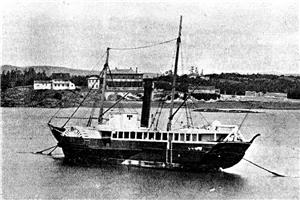On June 18, 1836, the Hudson's Bay Company ship Beaver, the first steamship to travel on Puget Sound, departs Fort Vancouver for her first journey in the Pacific Northwest. The vessel carries two 35-horsepower wood-fueled steam engines, and consumes 40 cords of wood per day to travel an average of 30 miles.
The Beaver was 100.75 feet long and 20 feet wide. It was built at the Thames River in Blackwall, London, and launched on May 2, 1835. It was rigged with sails. The vessel set sail from London on August 29, 1835, with a crew of 13 men for a 225-day voyage to Fort Vancouver on the Columbia River, the main Hudson's Bay Company outpost in Western North America.
At Fort Vancouver, company employees attached two sidewheels (paddles 13 feet in diameter) to the ship and installed two 35-horsepower steam engines. On June 18, the Beaver steamed away from Fort Vancouver on her first voyage north along the coast to various Hudson's Bay Company outposts and to Tongass in Russian America (the future Alaska). The steamship now carried a crew of 31 men including 13 woodcutters and four stokers.
On the southbound journey, the Beaver entered Puget Sound. The ship’s destination was Fort Nisqually, a Hudson's Bay Company outpost located between the future sites of Tacoma and Olympia.
Much Detained by Fogs
The Journal kept at Nisqually, which usually did no more than note in a perfunctory way the weather, jobs performed, and furs collected, describes the arrival of the Beaver as follows:
"November 12th, 1836
This morning we were greatly surprised with the arrival of the Steamer Beaver, Capt. Horne on board of her .... This vessel is from Mill Bank Sound [Alaska], and has been much detained by the fogs in coming hither" (Journal of Occurrences...).
The 13 or so woodcutters immediately got to work chopping wood to fuel the steam engines. It usually took the woodcutters about two days to get enough wood, about 40 cords, to keep the engines running for one day. (A cord of wood is a stack four feet high by eight feet long by two feet wide.) The ship was able to travel about 90 miles on 40 cords, so its daily average would have been 30 miles a day.
The Beaver continued to steam up and down the coast under various owners until in 1888 it shipwrecked on rocks near Vancouver, British Columbia.

